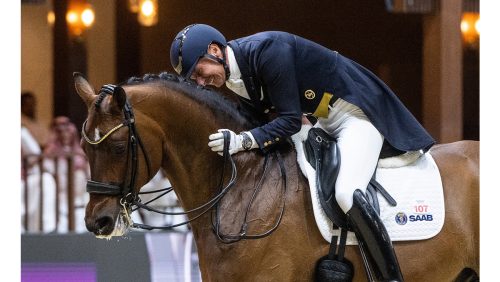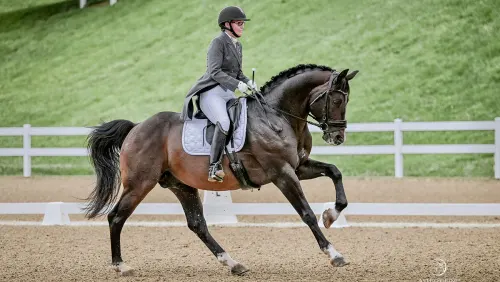Gunther Alberding, musical director at the FEI World Cup Final in Las Vegas, made quite an impact with his scripted background music for each Grand Prix test.
It was a new concept in the United States–but individually selected background music, choreographed in real time, is the sport standard at major European shows.
“We started doing this in 1998, and the first big international show that we did was the 1999 European Championships,” said Alberding, who lives in Oldenburg, Germany. “The FEI said ‘no’ at first, but then they realized it was nicer for the audience, and now we are busy every weekend.”
Mariette Withages, chairman of the FEI Dressage Committee, is still a bit tentative about the potential effect on the judging, though.
“Some music may not go as well with one horse as another,” she said. But when asked if the background music influenced her judging, she bristled, “I would hope not!”
Axel Steiner of San Marcos, Calif., another member of the Las Vegas jury, said, “I like the scripted music as long as it remains background and isn’t dominating or loud. Music puts a soft blanket over everything surrounding the dressage arena, drowning out just enough background noises to properly concentrate on the performance. And, let’s face it, everything looks just a little better with the right music.”
Alberding was a horseman first and an audio engineer second. His family raised warmbloods in Oldenburg, Germany, and he considers himself a horseman and dressage enthusiast, although he hasn’t ridden in years.
As a professional sound technician, Alberding started working horse shows in 1992. By 1996, he was so busy he gained a business partner, Regine Kayser, and they were married in 2002. Other than consulting, Alberding has given up the “hardware” end of the business and now just travels with his laptop computer, which he integrates with the facility’s sound and mixing board.
He has more than 200 selections of music, color coded by genre and text coded for walk, trot and canter tempo. After he familiarizes himself with each horse’s style of movement, he chooses appropriate selections for each gait. He knows the tests, and he synchronizes the music in real time with a scroll, highlight and a mouse click.
With an eye on the performance and his hands on the computer and mixing board levers, he fades the music in and out in time with the transitions and test highlights.
Alberding’s selections also take into consideration the rider’s nationality, and his goal is to enhance every ride. He tries to stay within the same genre; if it starts with Beatles, he tries to stay with Beatles.
Knowing almost all of the European riders makes it easier to produce the right sound at ringside, but if an unfamiliar horse enters the ring, he watches the horse warm up and selects music on the spot. If his initial selection isn’t ideal, he changes it at the next transition.
ADVERTISEMENT
“In Germany it took several years before somebody really noticed [the scripted background music],” Kayser said with a smile.
Alberding added that the riders don’t usually notice the music, because in most venues they can direct the sound solely at the audience. “But the ones who do notice it, they like it,” he said.
His selections are popular with trainers, and he’s often asked to design freestyles. “But I have no time,” he said. “I have a friend who does free-styles, and I refer them to him.”
For freestyle classes, Alberding said a preliminary sound check just isn’t enough to be sure the music is carrying to the riders, as well as to the judges and to the audience. Radio contact with Kayser, positioned ringside with the trainers, helps with volume control.
“[The European standard] is two separate systems,” Alberding said, “One for the audience and one for the riders.”
In venues such as the Thomas and Mack Center in Las Vegas, Alberding said, the single sound system must be pushed too loud for the audience in order to give the riders adequate volume on the floor.
“There really should be two separate sets of speakers–one for each,” he said.
The sound levels at the Thomas and Mack Center were frustratingly inconsistent. Photographer Terri Miller said, “I was standing in the ‘kiss-and-cry’ area at ring-side, where the grooms and coaches could watch. The opening ceremonies started, and I thought, ‘I must be getting old–I just can’t stand music this loud anymore.’ But then I noticed that all the 20-some-thing grooms had their fingers in their ears too!”
At most of the European venues he works, Alberding also controls the lighting. He was critical of the lighting capabilities in Las Vegas, explaining that the arena floor should be much brighter and the stands in the dark.
Good theatrical lighting adds drama, he explained, minimizes distractions in the stands, and helps keeps the audience quiet and seated. Modern lighting systems utilize shutters, for easy muting without the warm-up delay associated with turning lights off and on.
“Correct lighting is important for good television and photos for the journalists,” Alberding said. “And sponsors are happy if they can stand in a spotlight among a crowded arena.”
Alberding’s company is E Media Design, based in Oldenburg. He and Kayser work as a team. Excluding travel, they charge roughly $520 per day, which includes the computer and all the music, but doesn’t include a sound system. They charge an additional $350 to $600 per day to arrange for a sound system and TV-quality lighting if a site doesn’t have them.
ADVERTISEMENT
Kayser believes that before “dressage booms in America, you need more famous or popular riders and television, which brings the sport home to the people.
“And nice and varied music makes dressage more interesting and not boring. In my opinion, it emphasizes the harmony and artistic qualities of this sport,” she added.
Why Light Really Matters
“We photographers were intimately aware of the low light levels” they’d be working with for the FEI World Cup Final at the Thomas and Mack Center in Las Vegas, said veteran Terri Miller, of San Marcos, Calif. “But we were also made aware of the physical limitations of the house system.”
Charles Mann, an accomplished freelance photographer who was the photo liaison for the International Alliance of Equestrian Journalists, offered an explanation.
“The biggest problem with the Thomas and Mack Center is that it’s over 20 years old,” Mann said. “On Thursday, the first day of competition, all the sets of house lights were on. But on Friday, I was informed after the morning production meeting that they would leave off a row of lights along the long side of the arena, thus leaving us with two-thirds the amount of light we had on Thursday–and this was how it would be for the rest of the competition. They said they needed that one row of lights for the award ceremonies. The problem was that the lights took too long to cool down and then come back to full power.”
Mann said that there are several ways arena and show managers can improve indoor lighting without major capital expenditures, including:
1. Add lighter-colored footing to help reflect light up.
2. Add light-colored bunting around the perimeter of the arena. These two steps decrease the effect of the riders’ dark coats and helmets. With dark footing and black bunting, photographers and TV cameras get no light reflecting up to fill shadow areas on riders’ faces.
3. Using spotlights during award ceremonies can be dangerous with horses. Using more general lighting during awards means that banners and signage behind the winners show up in awards photos. When photographers must resort to using flash, light from the flash doesn’t carry enough to light up the banners.
4. To maintain an adequate amount of light for competition and then have the right “mood” lighting for awards, Mann suggests retrofitting with shutters, so lights can be muted without cool-down/ warm-up delays.
“These are factors that each play a role in the quality and amount of light available. On their own they don’t sound like much, but once you add them up it has a big effect on the overall look and the amount of light needed to take a decent-quality photograph,” said Mann.
“Yes, these things cost money, but look at the ticket sales for this year and possible coverage from the media if the [Thomas and Mack Center] were better lit. A better quality of photographs from an event like this helps sell magazine readers on the idea of attending the next one, which equals more ticket sales. The editor and graphics person will use larger photos in their articles, because the photos will have less grain/noise and will be clearer.
“It all comes down to time and money,” Mann added. “The Thomas and Mack Center would not see the need for improving house lights because the majority of their productions don’t need all that light. And, overall, the conditions at this year’s World Cup were much better than in 2003.”














